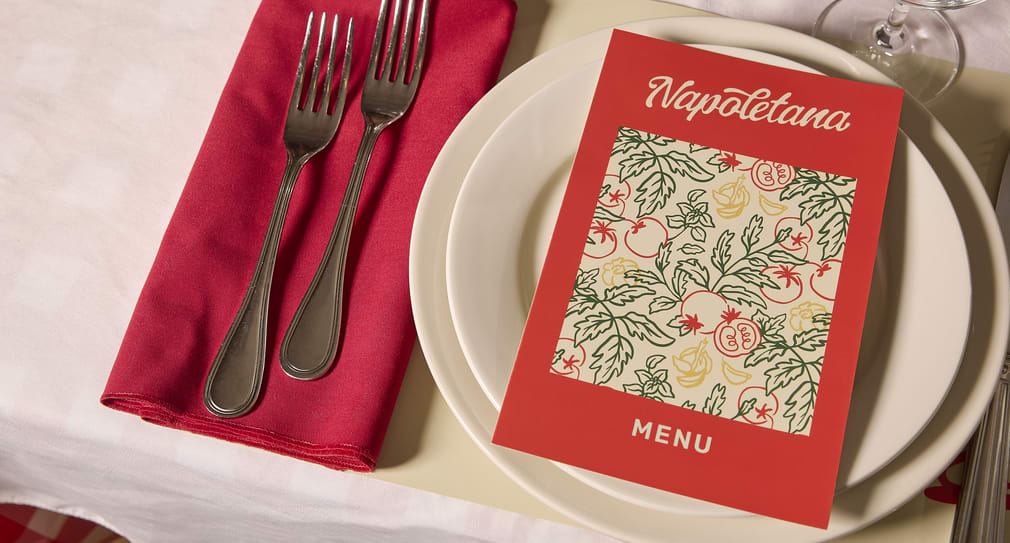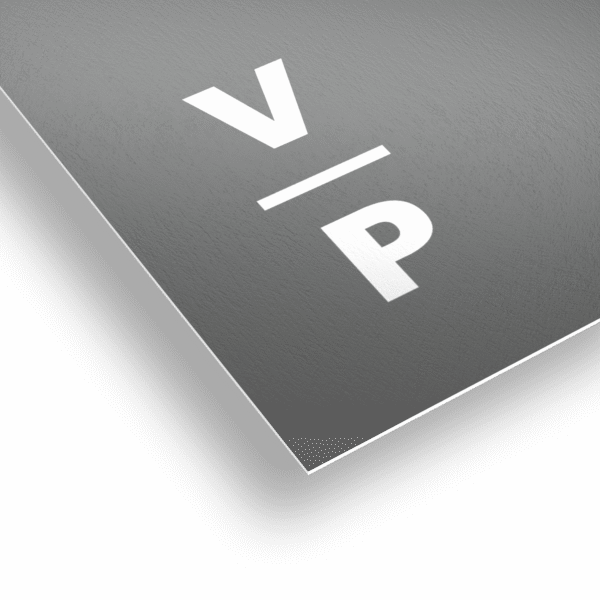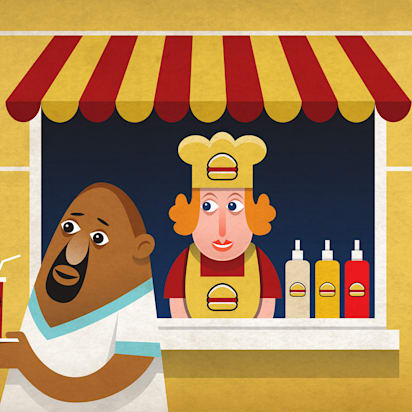A menu is the single most powerful sales tool in any restaurant. More than a list of dishes, it shapes how customers see your brand, what they order and ultimately how much they spend. That’s why knowing how to print a restaurant menu the right way matters as much as the recipes behind it.
This guide will help you decide which types of restaurant menus fit your business best. We’ll cover the classics—flat, bi-fold and tri-fold—then look at newer options like tabletop displays and QR code sticker menus.
To help ensure your menus work well for your business, we’ve included a list of factors to consider when choosing a menu format, an interactive flowchart to make the decision easier and practical tips for menu printing and design.
- A restaurant menu is a critical marketing tool that influences customer perception and drives sales.
- Before choosing a menu, consider brand identity, menu size, update frequency, budget and customer flow.
- Printed restaurant menus include flat, bi-fold, tri-fold and multipage options—each with unique strengths and ideal use cases.
- Alternative menus such as tabletop displays and QR code stickers can be cost-effective and flexible.
- Smart menu printing and design choices—like using durable finishes and clean layouts—help save money and boost customer experience.
Factors to consider before choosing a menu format
Choosing a menu format goes beyond simply picking between flat, bi-fold or tri-fold and calling it a day. The right format supports your operations, reinforces your brand and shapes how customers interact with your food.
Before you dive into the types of restaurant menus available, step back and assess what your business actually needs. Here’s what to look at:
Brand identity
Your restaurant’s identity should be the starting point for every design decision (including how your menu is printed and structured).
- Fine dining or upscale concepts: You want something refined and minimalist, like a sleek flat menu.
- Casual cafés or coffee shops: Your creative options, combos, descriptions and add-ons need room to shine! Consider a trifold menu.
- Takeout or quick-service spots: Portability and durability matter most, so go for something small and efficient, like a QR code to your menu.
Keep it clean and focused (brand colors, themes, etc); bulky menus with clip-art-style images can undermine a carefully crafted aesthetic.
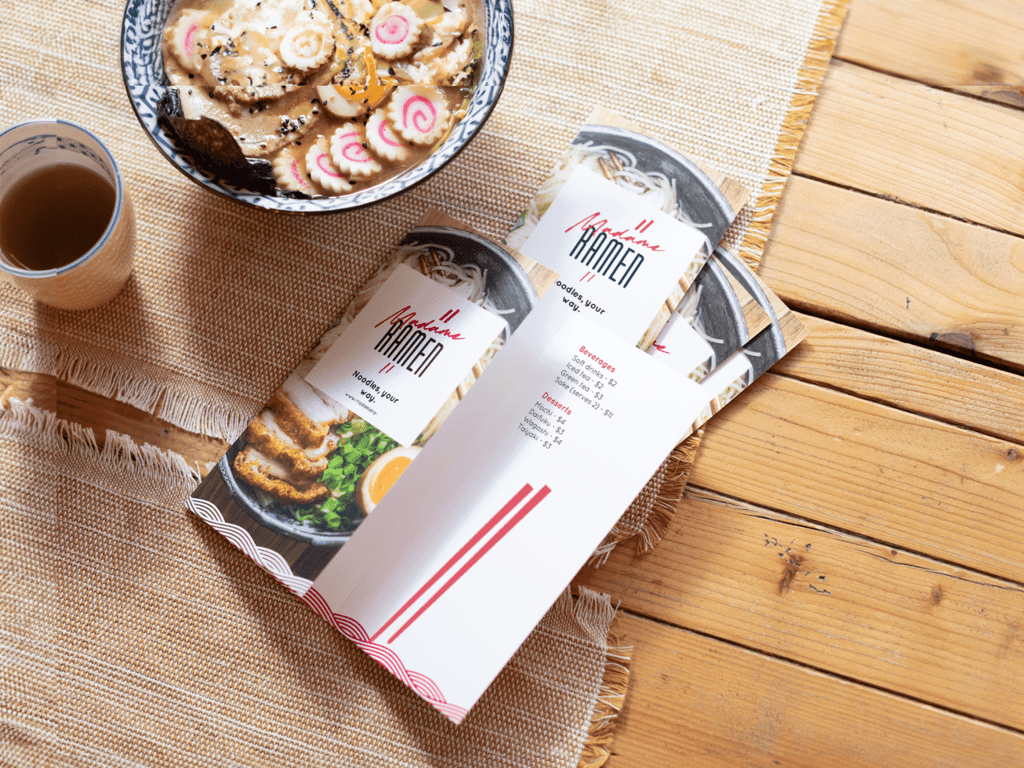
Frequency of menu updates
Some restaurants rotate their offerings weekly. Others haven’t touched their menu since 2016.
If you’re in the first camp, your format needs to keep up. Printing a new tri-fold every three days? That’s a budget black hole. In that case, you’re better off with a slim, flat menu for daily specials or even integrating a QR code into a reusable print piece.
On the flip side, a fixed menu allows for more intention with the format. You can invest in something more polished without worrying about a full reprint every time your chef has a new idea.
Or you can have both! Use a fixed menu for your consistent offerings, and small, flat print outs you can rotate with your monthly or weekly specials.
The key is to balance form and function. Choose a format that looks good—but also makes financial sense every time you hit reprint.
Menu size
How many dishes you offer shapes the layout. A short, focused menu fits neatly on a flat or bi-fold format. But if you’re listing everything from sushi rolls to Sunday roasts, you’ll need more space—and structure. That’s where tri-folds shine, with clear sections that keep things digestible.
Keep in mind that more pages mean more complexity and slower updates, which ties directly back to how often your menu changes.
Restaurant customer flow
How quickly your customers move through your space plays a big role in menu format. The longer they spend with the menu, the more structure they can handle.
- Fast-paced setups (e.g., food trucks, delis, counter-service cafés): Flat menus work best. They’re quick to scan, easy to print and simple to swap out as needed.
- Sit-down restaurants with longer dwell time: Bi-fold, tri-fold or multipage menus give diners room to browse, compare and take their time with the options.
Target audience
Last but definitely not least: who’s reading your menu? Your menu format should reflect your audience’s preferences—not just what works operationally behind the scenes. Some guests want photos with every item, others prefer a minimal, ingredient-led layout.
Some examples include:
- If you’re serving families, clarity and legibility should take priority over clever design.
- If your crowd skews younger, they can scan a QR code and browse on their phones.
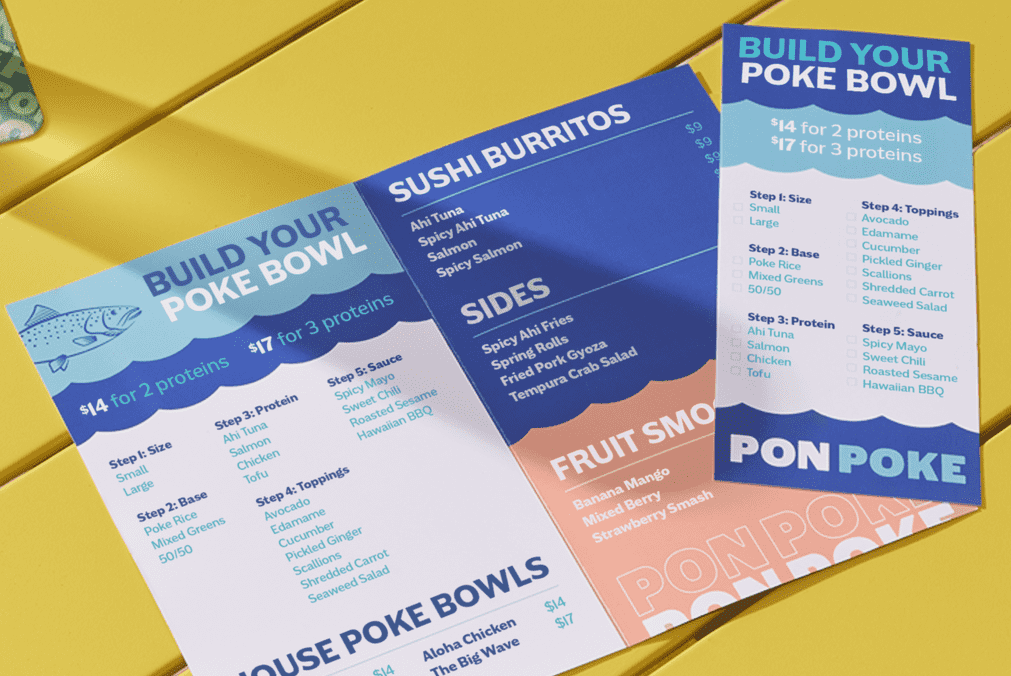
Types of restaurant menus and when to use them
Once you’ve worked through the factors that shape your decision—from brand identity to budget—you’ll be in a better position to match your needs with one of the popular menu formats. What your customers expect and what your operations demand should come together in the type of menu you choose.
Below, we’ll look at the most common printed restaurant menus as well as some alternative formats that have been gaining ground in recent years.
Printed restaurant menus
Even in an increasingly digital world, plenty of diners still prefer holding a menu in their hands. Depending on the factors covered earlier, most restaurants end up with one of four popular printed formats. Each offers different benefits and trade-offs worth weighing carefully.
Flat menus
A flat menu is a single sheet—simple, direct and cost-effective. They’re common in quick-service restaurants and bars where speed is essential.
You can print them on standard paper, heavier card stock or laminate them for durability. Popular sizes include 3.75″ x 8.25″, 8.5″ x 11″ and 11″ x 17″, giving you flexibility depending on how much space you need.
Pros of flat menus
- Affordable and easy to reprint
- Great for specials and seasonal items
- Fast to hand out and replace
Cons of flat menus
- Limited space for larger menus
- May look too plain for upscale restaurants
- Easy to wear or damage without lamination
Best for: Small menus, daily specials, food trucks or fast-paced cafés where customers don’t spend much time deciding.
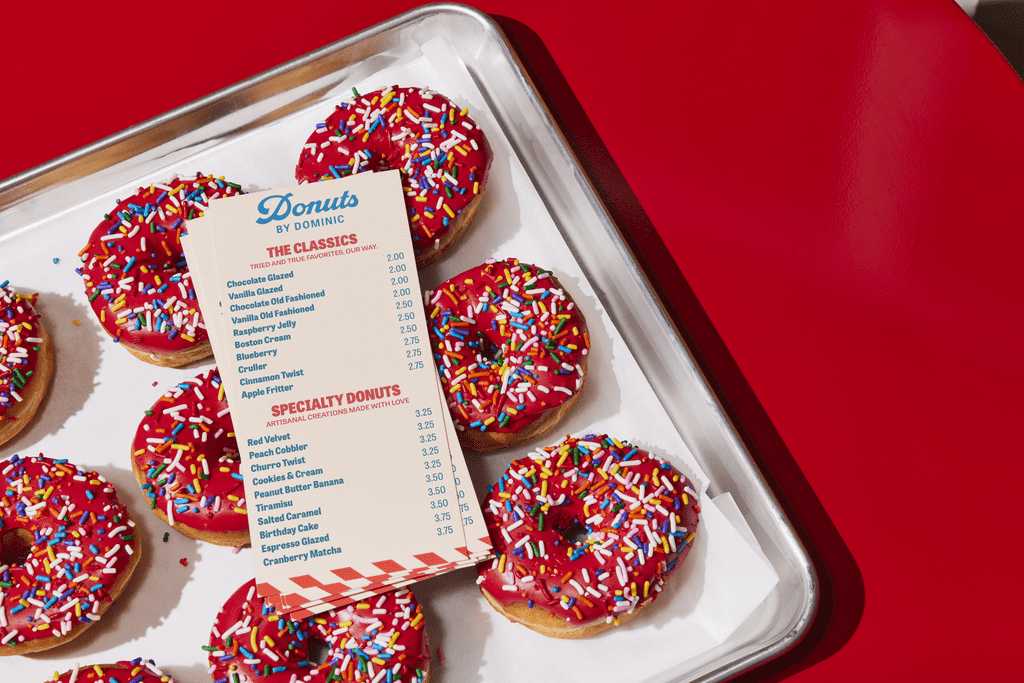
Bi-fold menus
Bi-fold menus are created by folding a single sheet in half, giving you four panels to work with. They’re available in two standard sizes: 8.5″ x 11″ (8.5″ x 5.5″ folded) and 11″ x 17″ (11″ x 8.5″ folded). This structure balances extra space with a clean, organized look that customers can easily scan.
Pros of bi-fold menus
- Clear sections for appetizers, mains, desserts
- Compact but structured
- Professional look without clutter
Cons of bi-fold menus
- Costs more to print than flat menus
- Less room than tri-folds or multi-page formats
- Frequent updates can get expensive
Best for: Sit-down restaurants, mid-range cafés and bistros with a moderate selection of dishes.
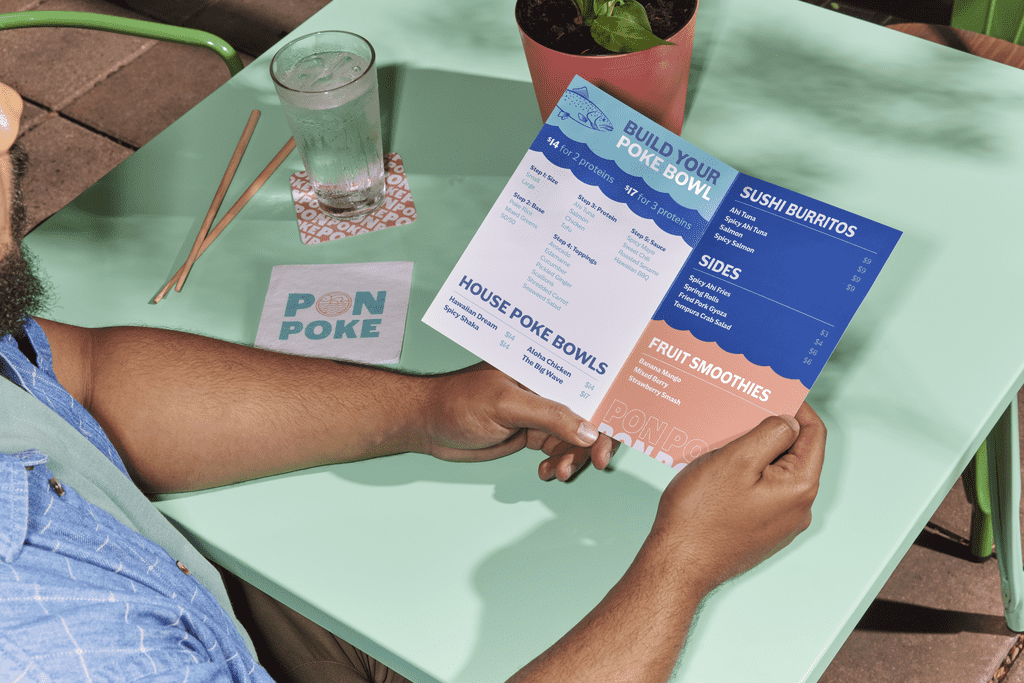
Tri-fold menus
The tri-fold menu is a classic type of restaurant menu, folding into six panels. Popular sizes include 8.5″ x 11″ (8.5″ x 3.6″ folded) and 8.5″ x 14″ (8.5″ x 4.6″ folded).
With more panels, you get room to separate categories and guide customers through the dining experience without overwhelming them.
Pros of tri-fold menus
- Ample space for larger menus
- Natural separation between categories
- Familiar and easy for customers to navigate
Cons of tri-fold menus
- More complex to design well
- Higher print cost than bi-folds
- Frequent updates are less practical
Best for: Restaurants with larger menus—diners, family restaurants or cafés that want to showcase variety without resorting to a booklet.
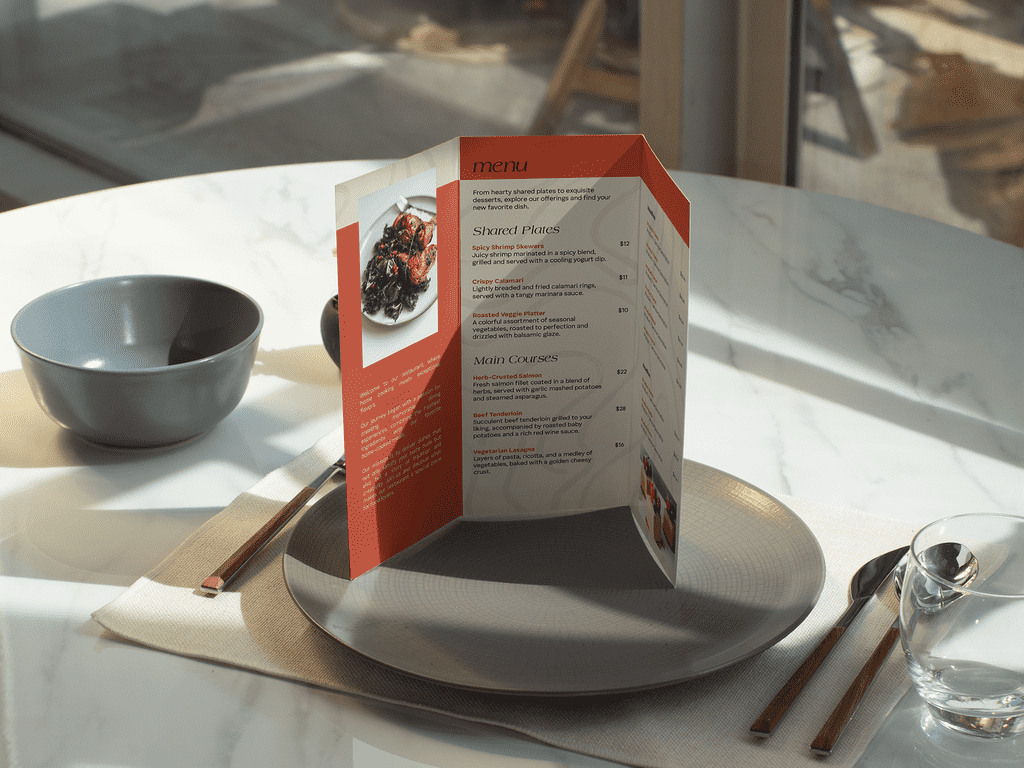
Multi-page menus
Multipage menus function like booklets and are common in restaurants with extensive offerings. They can handle everything from drinks lists to full-course menus, though they require more investment in both design and printing.
Pros of multi-page menus
- Plenty of room for large menus and visuals
- Allows creative layouts and storytelling
- Durable and professional-looking
Cons of multi-page menus
- Expensive to print and reprint
- Can overwhelm diners if not structured well
- Bulky compared to other formats
Best for: Restaurants with expansive offerings, such as international buffets or eateries with both food and drinks lists. Illustrated menus, where each menu item comes with a photo of the dish.
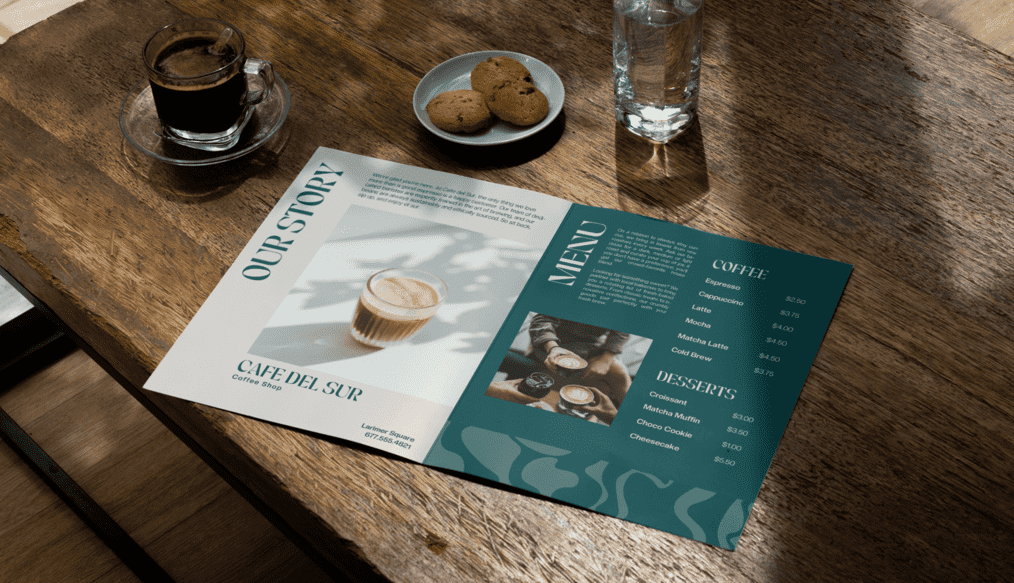
Alternative types of menus
Beyond printed restaurant menus, there are newer formats shaped by customer expectations and operational benefits. Rising eco-consciousness and the need to update menus quickly without frequent reprinting have driven interest in digital-first approaches.
Two options in particular have become popular complements—or in some cases, alternatives—to traditional formats.
Tabletop display menus
Tabletop displays are stand-up menus placed directly on the dining table, often focusing on promotions, drinks or add-ons. They’re durable, visible and don’t require servers to hand them out, though they usually supplement rather than replace a main menu.
Pros of tabletop display menus
- Always visible to customers
- Great for highlighting specials or upsells
- Low reprint frequency compared to paper menus
Cons of tabletop display menus
- Limited space for full menus
- Requires sturdy materials to withstand wear
- Can clutter tables if overused
Best for: Restaurants that want to promote seasonal specials, signature drinks or upsell items without constantly updating their main menu.
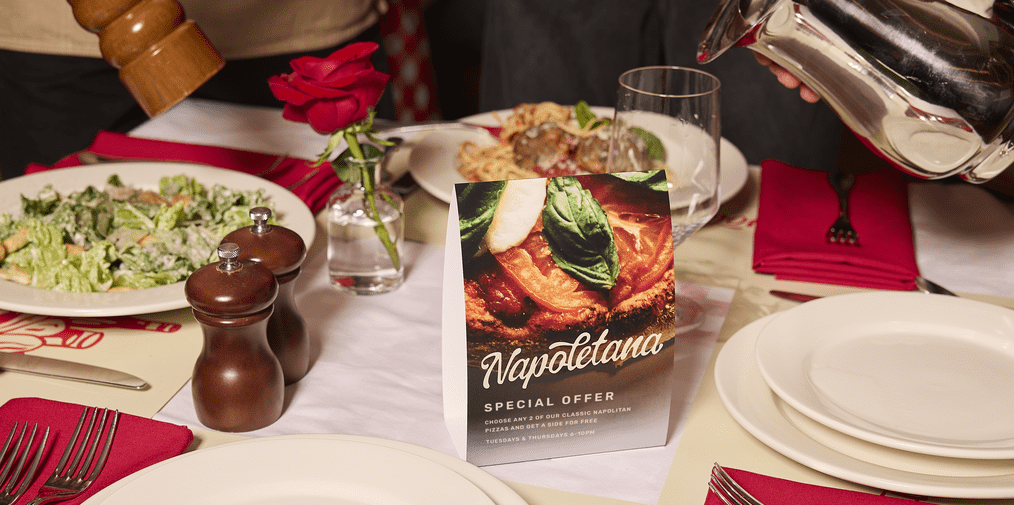
Use tabletop displays to highlight only selected offerings and add a QR code, leading customers to the full menu.
QR code sticker menus
QR code sticker menus link directly to a digital menu that customers can view on their phones. They save on printing costs and allow instant updates, but not every diner is comfortable with smartphone-only ordering. Only go for this menu type if you’re confident your target audience will appreciate it.
Pros of QR code sticker menus
- No ongoing print costs for updates
- Easy to update in real time
- Saves table space and simplifies service
Cons of QR code sticker menus
- Not everyone wants or can use their phone
- Risk of excluding some customer groups
- Requires reliable Wi-Fi or data access
Best for: Trend-driven cafés, breweries and restaurants targeting tech-savvy audiences but still accommodating a mix of diners.
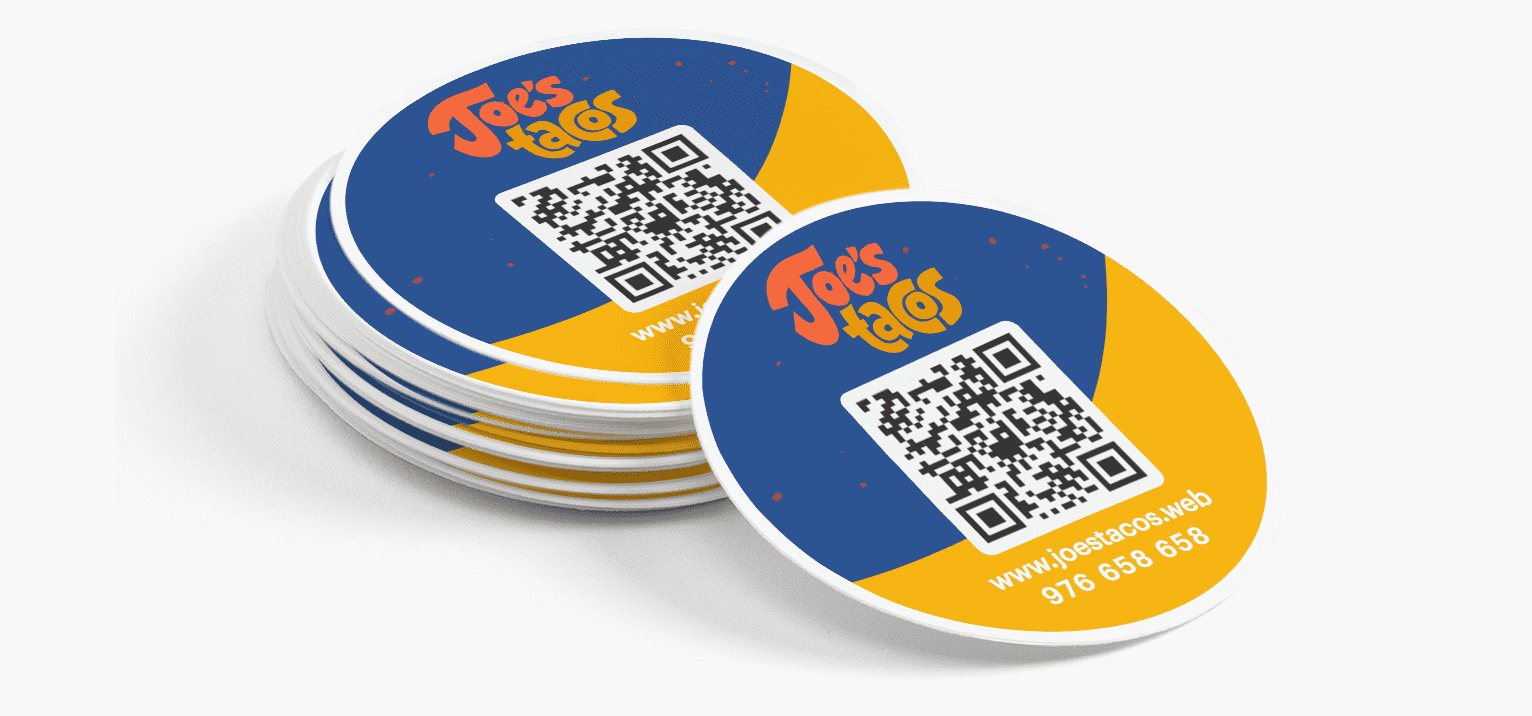
A safe option is to combine QR code stickers with a smaller number of printed menus. You’ll cut printing costs while still catering to customers who prefer a traditional format.
“Which menu is best for me?” flowchart
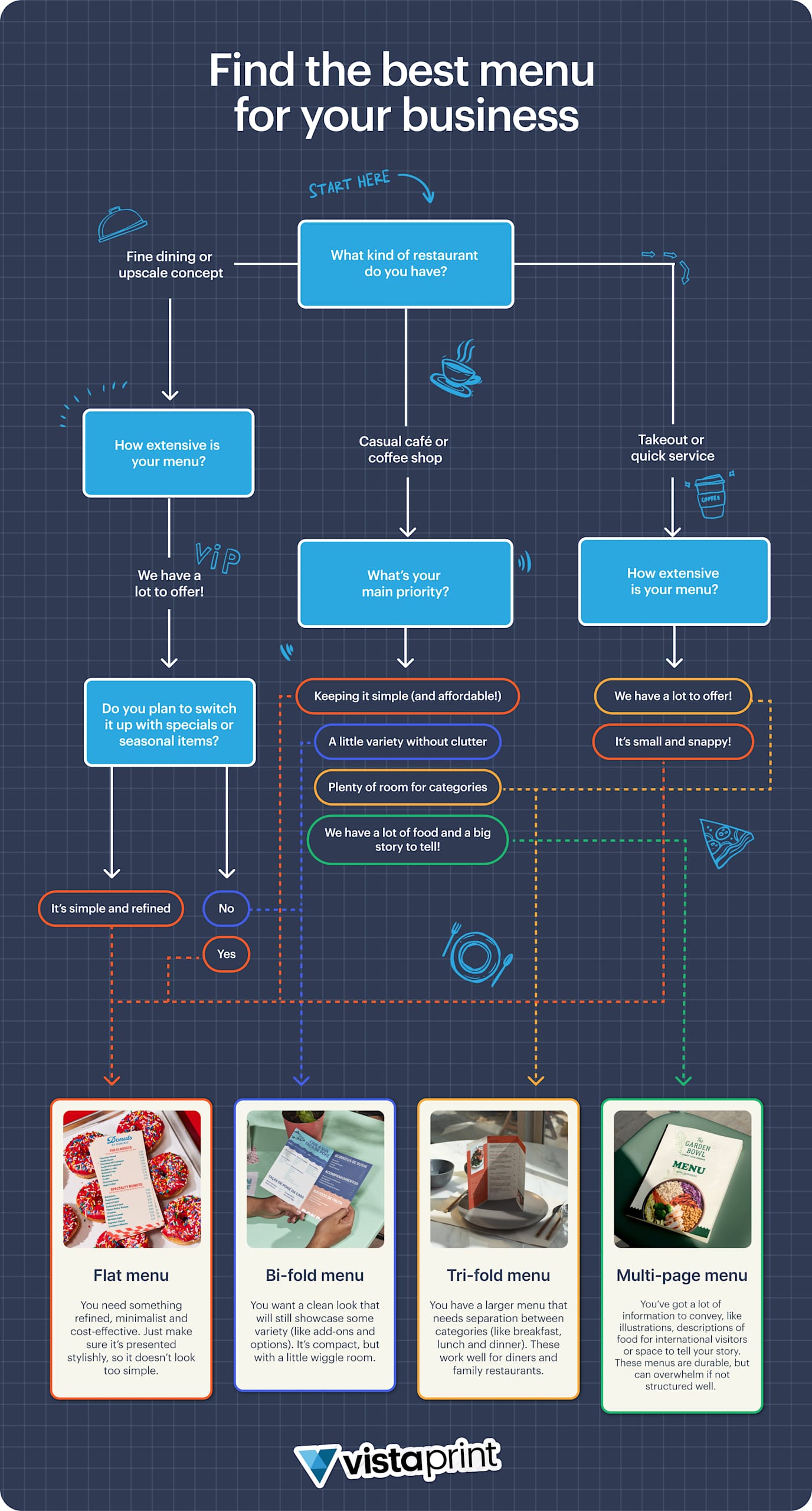
How to print a restaurant menu
Once you’ve chosen the right format, the next step is making sure the final product does its job: attracting attention, standing up to daily use and staying within budget.
Here’s how to make smart choices at every stage of the menu printing and design process.
Match menu type to your goals
As covered in the overview of popular types of restaurant menus, the right format depends on what you want your menu to accomplish. Here are some common goals and the formats that best align with them:
- Fast turnover and quick service → Flat menus
- Balanced structure with moderate dish variety → Bi-fold menus
- Room for larger menus and clear separation of categories → Tri-fold menus
- Extensive offerings, drinks lists or specialty menus → Multipage menus (booklet-style)
If you’re still undecided, use the flowchart above to quickly match your restaurant’s needs to the right option.
Choose size/material/finish based on use and budget
How your menu feels in a customer’s hands matters almost as much as what’s on it. The material and finish you choose determine durability, cost and presentation.
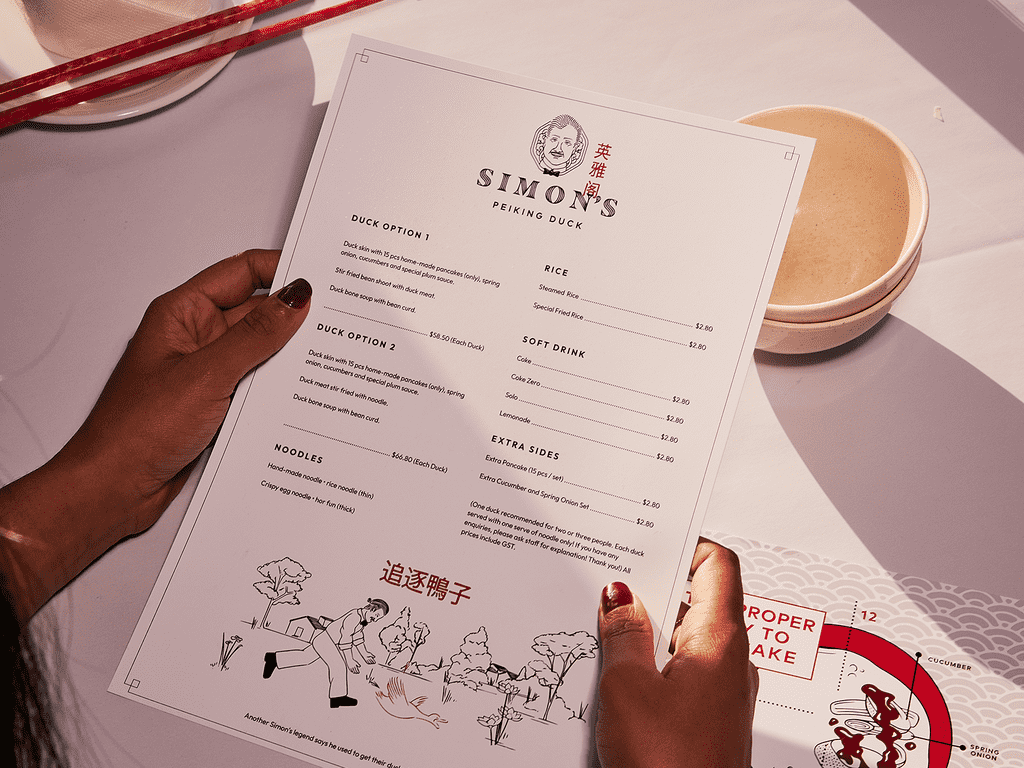
Menu paper sizes
Different menu sizes serve different purposes, so start with your content and match the format accordingly.
- Flat menus come in 3.75″ x 8.25″, 8.5″ x 11″ and 11″ x 17.” The smallest works well for drink lists or specials, while the larger sizes fit full menus in quick-service or casual settings.
- Bi-fold menus are available in 8.5″ x 11″ (folded to 8.5″ x 5.5″) and 11″ x 17″ (folded to 11″ x 8.5″). Both give you four panels; the smaller is more compact, while the larger provides extra room to separate categories.
- Tri-fold menus come in 8.5″ x 11″ (folded to 8.5″ x 3.6″) and 8.5″ x 14″ (folded to 8.5″ x 4.6″). The smaller size suits mid-sized menus that need clear sections, while the larger gives extra space for extensive offerings or visuals without feeling cramped.
Choosing the right size prevents two common problems: oversized sheets with too little content or cramped layouts that are hard to read.
Menu paper types
Standard paper works for temporary or high-turnover menus, but it won’t hold up for long in a busy dining room. Premium cardstock feels sturdier and more professional—worth the investment for restaurants that want menus to double as a branding tool.
Menu finishes
Menus take a beating—spills, food stains and constant handling are inevitable. While laminated menus cost more upfront, they pay off in the long run for casual spots or anywhere menus are reused frequently.
Some popular finishes include:
- Glossy highlights vibrant colors, ideal for restaurants with strong visuals or photos.
- Matte gives a sleek, sophisticated look that fits upscale dining.
- Synthetic or laminated menus are waterproof and easy to wipe down, making them the most practical choice for high-handling environments.
Here’s what VistaPrint offers for 8.5” x 11” bi-fold menus and our prices for comparison:
| Glossy | Matte | Recycled | |
|---|---|---|---|
| Standard thickness | $2.06 / unit | $2.06 / unit | $2.32 / unit |
| Premium thickness | $2.32 / unit | $2.32 / unit | N/A |
Design your menu
Once you’ve selected the menu type, size, material and finish, you’re ready to design your menu. You can hire a designer or design it yourself, either from scratch or using custom menu templates.
Tips for designing a successful menu
For a deeper dive, see our guide on how to design a menu—but here are the essentials when it comes to design and printing:
- Proofread carefully: A single typo can mean a costly reprint.
- Keep it clean and readable: Don’t overcrowd panels, and think carefully about font choice. For more on this, check out our article on serif vs sans serif.
- Guide customer choices: Place high-margin dishes in prime spots—typically the top right or center of a panel.
- Stay on brand: For consistency, your menu should echo your restaurant’s colors, fonts and imagery.
- Plan for durability: Match finishes to your environment—laminated menus for casual, high-traffic spots or premium matte/glossy finishes for fine dining.
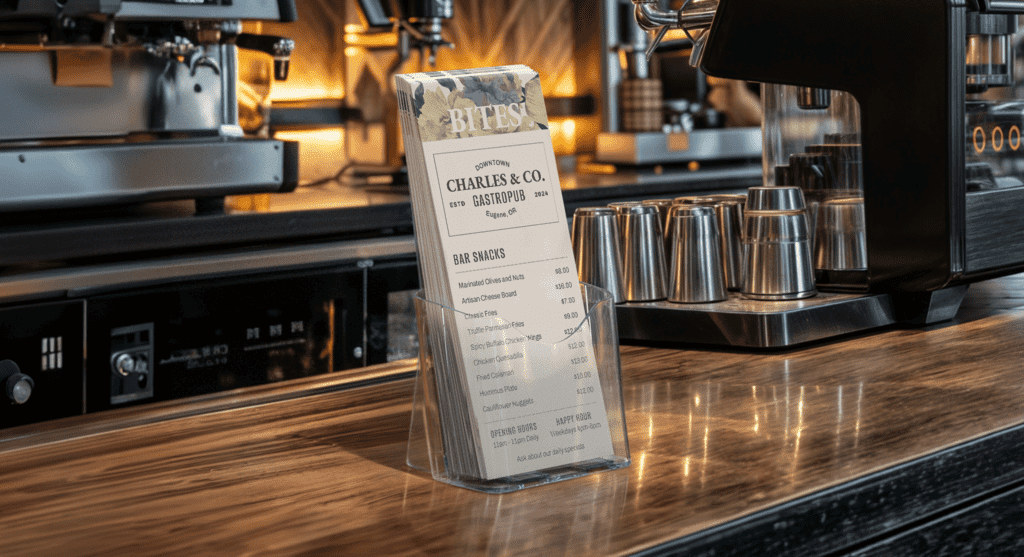
Print your menu
Now, the moment you’ve been waiting for: after finalizing your design, your menus are ready for printing!
If you have a small budget, you can print your menus yourself—but it will be more difficult and time consuming to achieve a professional look and feel. Alternatively, you can print your menus with a printing company like VistaPrint. While it may be slightly more costly, the difference is made up for in time saved and professional quality.
Ready to ace menu printing and design?
The right menu does more than list dishes—it shapes how customers order, influences what they spend and reinforces your brand at the table. A flat sheet, a polished bi-fold or a durable laminated tri-fold each sends a different message and serves a different purpose.
The key is alignment. Match the format and material to your restaurant’s style, your customer’s preferences, the size of your menu and the budget you can sustain. When those elements line up, your menu becomes a sales tool that works quietly but effectively in the background—guiding choices, driving revenue and leaving customers with a lasting impression of your brand.
